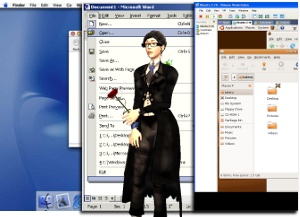 If you’re a Mac user, you know you’ve got access to a whole slew of first-class applications. That is, apps that follow the user-interface style guidelines for the Mac. Painstakingly developed and tested over time, the guidelines ensure consistent layouts of menus, options and hotkeys, so that you don’t spend your time struggling to work out how to do the familiar, when you should be getting on with gaining expertise in the unfamiliar.
If you’re a Mac user, you know you’ve got access to a whole slew of first-class applications. That is, apps that follow the user-interface style guidelines for the Mac. Painstakingly developed and tested over time, the guidelines ensure consistent layouts of menus, options and hotkeys, so that you don’t spend your time struggling to work out how to do the familiar, when you should be getting on with gaining expertise in the unfamiliar.
Windows also has it’s own user-interface conventions (though they are not so strongly adhered to), and Linux has its own body of user-interface conventions also (though mostly just a matter of custom).
The thing is, the applications that follow those local rules are quite simply easier on the user, and that gives them a popularity boost right there. You don’t have to think about the hotkeys for saving or quitting. You don’t have to search high and low to find preferences. Your first-class applications are all laid out in the same way, where they have anything in common.
Second Life, however, isn’t a native first-class application on any of the three supported platforms. It sports an interface that’s somewhat alien to all three. My contention here is that perhaps an attempt should be made to actually give the Second Life viewer an overhaul and actually give each platform a native-style first-class UI.
i.e: Have the Mac viewer follow the Mac UI conventions for menus, hot-keys, drag and drop. The whole nine-yards. Windows and Linux viewers should get their UI reworked to follow their local conventions, too.
Sure, there’s a downside to this. More limited opportunities for cross-platform tutorials and documentation, you’d need to triple-up in some cases. Plus extra work from developers and QA.
The question is, however, who are we supposed to be making the viewer UI easier for? Documenters, devs and QA staff, or the actual users? The unified cross-platform interface doesn’t do the user much in the way of favours, and frankly not many second-class applications ever really hit the heights of popularity on any platform. Without following native user-interface conventions, you’re ultimately deprecated somewhat by the very people you need to win over: the actual users.
Ultimately, though, this is something that needs to be proven out by experiment before you can say for certain that a first-class native-conformant UI will do a better job than the existing second-class UI.
With a variety of third-party Second Life viewers out there the question is, who will be the first to try the idea out? I don’t think it will be Linden Lab.
Recent Comments